You’ve heard it all, every January, about how to set goals and how to achieve them, but if you’re like many, those goals can fade within a couple of weeks or months. In fact, polls suggest that up to 80% of New Year’s Resolutions have been abandoned by mid-February and only 8% of people have actually attained their goals by the end of the year. Research suggests that we look at goal setting in two dimensions: motivational (the will) and cognitive (the way). Changing complex behaviors usually requires both (Berkman, 2018). It’s important to know how to set the goal in brain-friendly, momentum-building ways (the will), and to be able to execute the goal by tapping into executive functioning skills (the way). Executive function creates and coordinates behaviors to achieve novel, complex, effortful goals. In fact, coordinating behaviors to achieve novel goals is the basic role of the entire prefrontal cortex (Miller & Cohen, 2001). In other words, your brain is hardwired to create and achieve goals! By using cognitive science and a series of easy-to-use metacognitive steps, you can set truly valuable, needed goals that you can accomplish so that you can achieve the desires of your heart or the needs in your life.
Below is a preview of my Maximize Goal-Setting Template. I’ve used this template for years in many different settings: in high-poverty schools to help them close their gaps, with individual teachers during coaching, with leadership teams, and in my own personal life. This template is designed to take the complex process of goal setting and make it simple, yet still highly effective. You’ll get the chance to break this down, explore the logic behind it, and work through the pieces right inside this article. Plus, my personal Maximize Goal-Setting Template is completely filled out for you at the end so you can see an example.
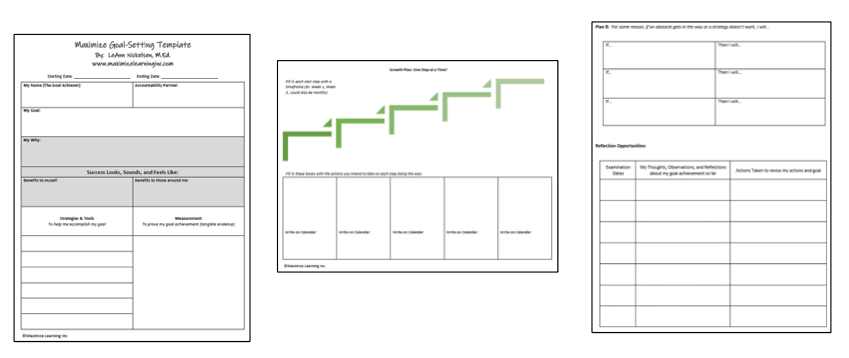

The What
You might have a goal already in your mind that you’re ready to get to work on. Or, you might not. It can be a challenge to identify a goal strong enough to sustain your commitment in the long-term. Here are some exercises that can help you find a durable goal:
- A Day in the Life. Take a minute and mentally walk through an average day looking for “pinch points” – the same problem that comes up again and again. Solving these pinch points might be a goal in and of itself, or these pinch points might alert you to something bigger that needs to be addressed.
- Feelings Check. Negative feelings exist to alert us to something in our life/environment that needs attention. Take a moment and scan your emotional world. What bothers or grates on you? What sucks your energy reserves dry? What makes you feel hopeless? Angry? Impatient? Frustrated?
- The Upgrade. Perhaps there’s something in your life that has served you well enough so far, but you’re ready to replace it with something that will create even more value for you. One way to maximize your odds for success here is to amplify the value of your new habit and decrease the value of the existing habit in order to optimize the behavior changes needed for the new one (Hare, Schultz, Camerer, O’Doherty, & Rangel, 2011).
- The Overhaul. There might be something in your life that is absolutely not working for you and simply needs to be addressed. If so, you’re probably already aware of it. (When you know, you know!) Lean into that work and use this template to get clear about what that will look like.
Once you determine what you want and need, write it here:

The Why
Now that you’ve figured out what you want to work towards, here’s an equation that will help you sustain your drive throughout the time it takes to achieve it.

Why is this goal needed or wanted in your life? How will it benefit you and others socially, emotionally, cognitively, physically, and spiritually? What will your life look like after you have accomplished this goal? A way to amplify the value of your goal is to determine how it is connected to your core values and your sense of self (Berkman, 2018). If you don’t have a strong Why and an amplified value of this goal, it’s going to be hard to find the will to continue on the goal journey.

Work with your brain’s natural goal-setting hardware by using visualization. By visualizing the outcome and rewards of accomplishing the goal, we are activating the dopaminergic reward system. Specifically, the ventral striatum experiences a big reward in the form of a nice dump of dopamine during visualization. Dopamine has been called the “Motivational Neurotransmitter” as it brings about good feelings that make you want to experience it again. There is a direct link among intrinsic motivation, dopamine release and the positive affective state of mind reflecting an energized appetite for “wanting.” With each step of success toward the goal, one should celebrate and point out the step of success which can dump some dopamine in the brain (Di Domenico & Ryan, 2017). Dopamine is an addictively good reward for the brain, so it’s definitely worth it to take the valuable time to visualize your life with the accomplished goal in place and how it will affect you and others.
Ask yourself these questions to help find a strong Why, amplify the value, and visualize this goal:
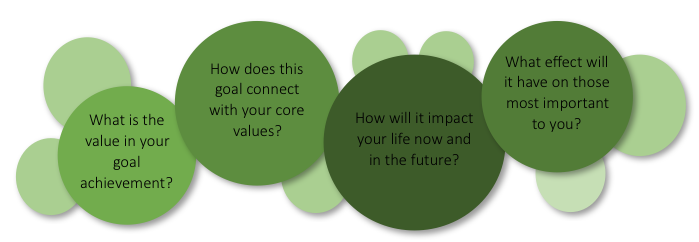
For example, you might have a goal to stretch every single day for 15 minutes. You chose this goal because your muscles are so tight that you get hurt often or have chronic pain. This, in turn, makes you feel weak and older than you think you should. A strong Why for your goal would then be, “To feel strong, young for my age, and physically capable every day.” Being physically healthy is a core value of yours – you read books, articles and blogs about health. You can amplify the value of this goal: by reflecting on the daily pain that you have, by listing the activities that you used to be able to do and can no longer do, by researching how Advil daily is not a good idea, etc. Finally, visualize yourself being able to do the activities that you love, moving without pain, looking in mirror and seeing posture of a younger person, etc. You get the idea – DO NOT SKIP these very important reflection steps before creating your goal. Buy-in is everything for momentum.
Consider your Why and visualize the goal attainment benefits for you and others. Write it here:


The Who
A study from Dominican University found that more than 70% of participants who sent a weekly progress report to a friend had an increase in goal achievement, whereas only 35% of participants who kept their goals to themselves were successful (Matthews, 2015). Ask yourself: who do I know that can help/encourage me towards this goal? Who will hold me accountable in my progress? (Be brave!) We all need encouragement to achieve great feats. Ask a trusted friend to help you accomplish this goal and volunteer to help that person as well. Write that person’s name here:


The How

The research indicates that when your goals are moderately tough and challenging, you get a large spike in your systolic blood pressure, or SBP (Cole, Riccio, & Balcetis, 2014). SBP is the measurement of the body being geared up and ready to act. In other words, there is more excitement in the brain and body when you set challenging, yet attainable goals. If the goal feels impossible, the SBP system writes it off. So how can you let your SBP system know that your big goal is still attainable? Focus on the strategies that will help get you there. It’s extremely important to gather information, ideas, strategies, and tools that will help you along the way. You also need to reflect on the sources of difficulty in achieving the goal. If you’re not sure, it’s time to ask the experts, to Google for ideas, to engage close friends to ask their advice, to read books, listen to podcasts, etc. Fill in the Strategies & Tools section with tangible, challenging (yes, bump it up) actions you can take to achieve your goals. Determine which ones will be the proof or evidence of your success and list them in the Measurement section. Quick Suggestion: create visual reminders of your strategies or tools and place them in locations that you see often (bathroom mirror has visuals of the dark green vegetables that you want to eat every day).
The When
The medial prefrontal cortex (MPFC) part of the brain helps you envision what it will be like to achieve the goal, and it also specializes in “turning on” the rest of your brain to help it work to achieve goals. But there’s a catch! If a goal seems too distant (or like it will take too long to accomplish) or if it seems too easy, the MPFC turns itself down, causing motivation to wane. So how can we work with our MPFC’s to achieve big goals? Break your big goal down into short-term, achievable steps and visualize the completion of each step (not just the end result of entire goal). Then, focus on achieving those smaller goals one by one. Executive functions can only be performed one at a time because they operate sequentially, therefore, be sure to prioritize the most important steps first. Take the above Strategies and Tools list, write out the details, and place them on the Stair Steps boxes below to break down your big goal into the doable sub-parts. Finally, sequence those steps based on priorities and how you can best build your momentum. Feel free to scroll down to the end of the article to see my example.
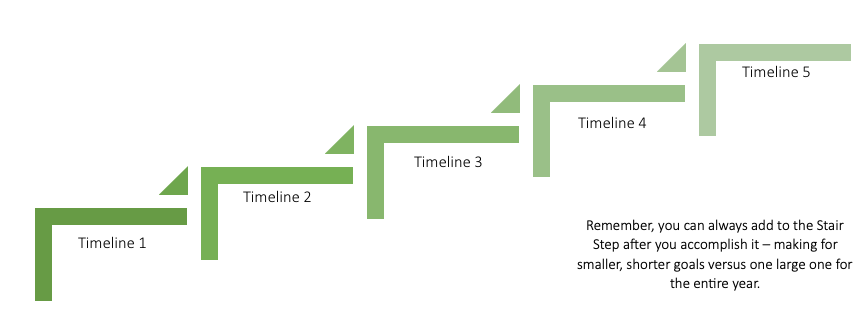
Fill in these boxes with the actions you intend to take on each step along the way (from The How):

Do something daily, consistently, to help you achieve this goal. Don’t forget to carve out time to use your new strategies or tools to accomplish the goal. This will require placing the new habits on your calendar – down to the days and times. They must become priorities rather than after-thoughts. I just bought a new calendar that has the quote on the front: “She designed a life she loved.” That is exactly what goal setting is all about: intentionally planning what you want your life to look like, breaking it down into steps and making each step count, daily.
What if an Obstacle Gets in the Way?
For those imperfect days and for when you forget to do an action item, what could you do rather than beat yourself up? Have a Plan B ready to go! A Plan B simply gives you another route to take when something (inevitably) goes wrong. When creating a goal, you should always create a Plan B according to goal-setting and goal-accomplishing expert, Dr. Peter Gollwitzer, Psychology Department professor at New York University. His research found that adding a Plan B to your goals can triple success rates for goal achievement: from 22% to 62% (Gollwitzer, 1999)! Plan B’s have an “If-Then” statement such as: If the following obstacle does get in the way, then I will do ___. For example: If I’m running late and don’t stretch before leaving the house in the morning, then I will stretch for 5 minutes before I eat my lunch. To have hope, we need goals and multiple pathways of achieving those goals.
Think through some things that might go wrong as you’re working towards your goal and what a feasible Plan B would be for several of your steps. Write them here:

Reflection Opportunities
Lasting change occurs when you take time to reflect. To reflect, you must examine the current status of the goal against where you’d like it to be. This step is easily forgotten, so make a plan for exactly when you’ll reflect and mark those dates/times in your personal calendar. After you reflect, adjust your stair steps based on what you’ve discovered.
Some areas you might choose to reflect on are: decisions, actions, behaviors or moods, thinking processes, emotional experiences, interactions with others, problems and possible solutions, personal health, and opportunities.
For now, just fill the dates that you’re planning to reflect:

Summary: The Checklist for Achieving and Accomplishing Goals
To summarize all the steps, I’ve created a checklist for the whole process. Why a checklist? First and foremost, when implementing a process, it helps to see all the steps together to know how to get the desired results. Checklists can increase your efficiency of your time to help you determine what must get done and what not to do (distractions). The brain can receive a little dopamine dump when small tasks are accomplished. I know I feel so much better after creating a manageable To Do list for the day and checking items off after I complete them. When the brain gets a whiff of dopamine, it will want you to repeat those behaviors. My goal setting template has:
|
|
|
|
|
|
|
|
|
|
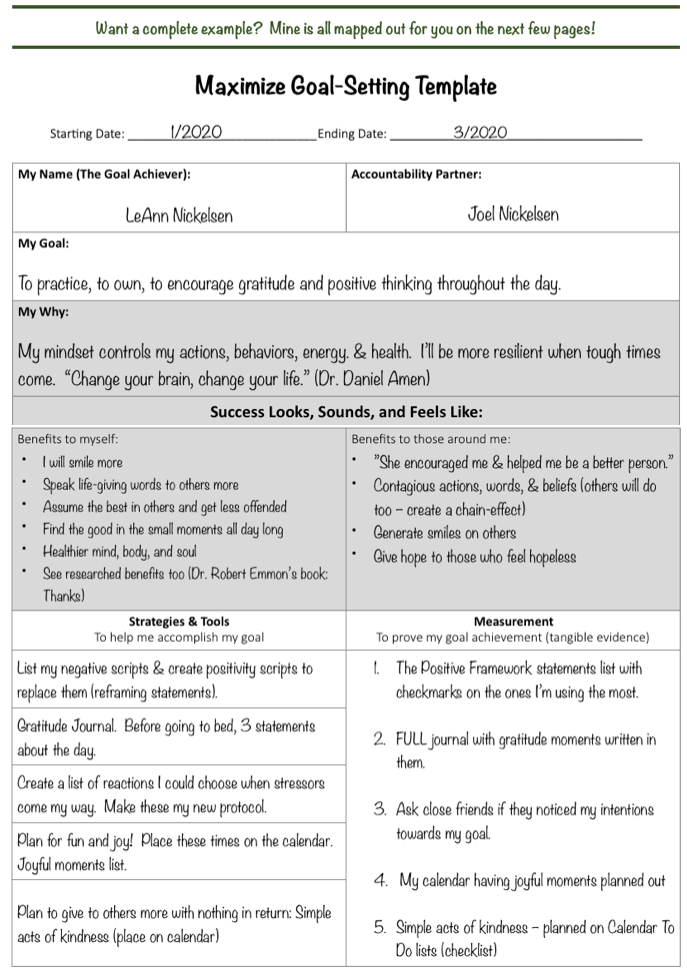
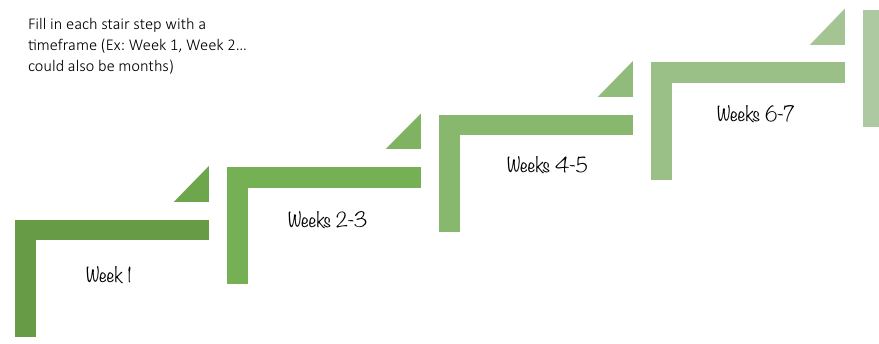
Fill in these boxes with the actions you intend to take on each step along the way:
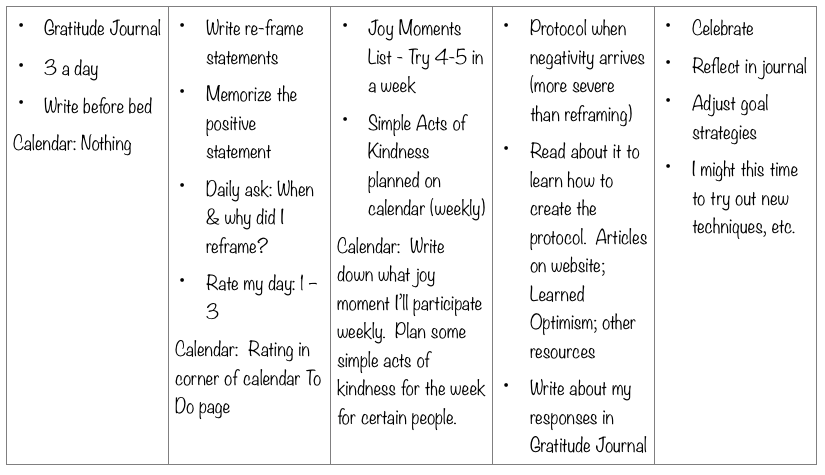
Plan B: For some reason, if an obstacle gets in the way or a strategy doesn’t work, I will…

Reflection Opportunities:
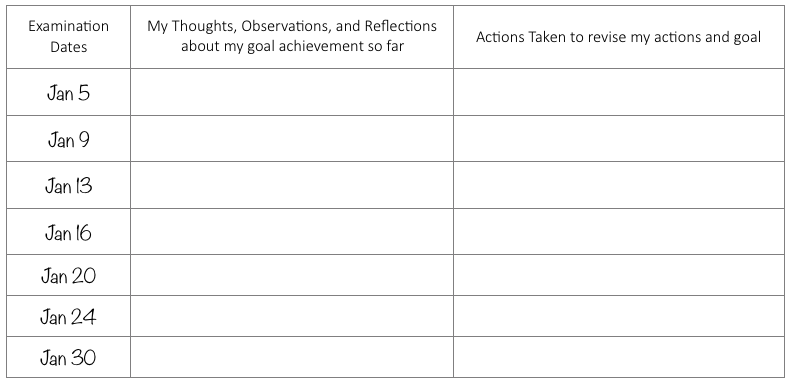
For the complete, blank template, please go to my website and visit the Maximize Coaching section for the downloadable, free template: https://maximizelearninginc.com/home/free-resources/
Reference List:
Berkman E. T. (2018). The Neuroscience of Goals and Behavior Change. Consulting psychology journal, 70(1), 28–44. doi:10.1037/cpb0000094
Cole, S., Riccio., M., & Balcetis, E. (2014). Focused and fired up: Narrowed attention produces perceived proximity and increases goal-relevant action. Motivation and Emotion, 38, 815–822.
Di Domenico, Stefano and Ryan, Richard M. (2017, March). The emerging neuroscience of intrinsic motivation: A new frontier in self-determination research. Front. Human Neurosci., 24 March 2017 https://doi.org/10.3389/fnhum.2017.00145
Gollwitzer, P. M. (1999). Implementation intentions: Strong effects of simple plans. American Psychologist, 54(7), 493-503.
Hare, T. A., Schultz, W., Camerer, C. F., O’Doherty, J. P., & Rangel, A. (2011). Transformation of stimulus value signals into motor commands during simple choice. Proceedings of the National Academy of Sciences, 108(44), 18120–18125.
Matthews, G. (2015, May). The Effectiveness of Four Coaching Techniques in Enhancing Goal Achievement: Writing Goals, Formulating Action Steps, Making a Commitment, and Accountability. Paper presented at the 9th Annual International Conference on Psychology, Athens, Greece.
Miller, E. K., & Cohen, J. D. (2001). An integrative theory of prefrontal cortex function. Annual Review of Neuroscience, 24, 167–202.
A big thank you to Contributing Editor, Tracie Steel. Tracie Steel is an educator living in Houston, TX. She’s always found her greatest joy in working with students and has served as a middle and high school teacher, a district-level instructional coach/curriculum writer, and a brain-based learning trainer. She is most inspired to continue her work as an educational consultant by her two wonderful children who remind her daily what a gift and responsibility it is to raise up the next generation. Visit her website at www.traciesteel.com.





